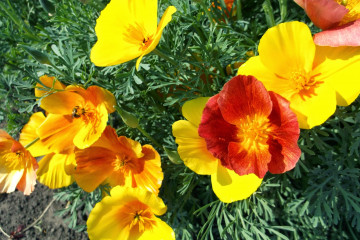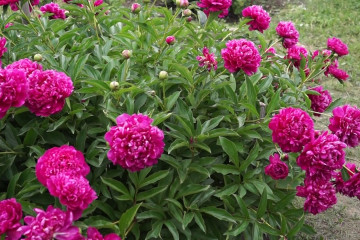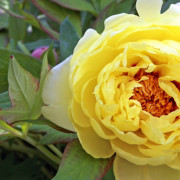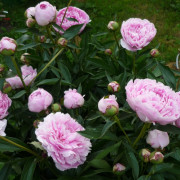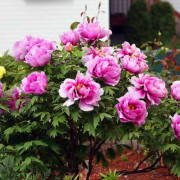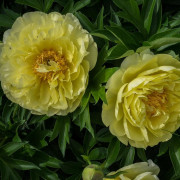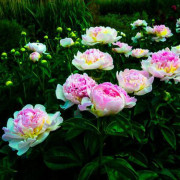When peonies bloom after planting in the garden
Content:
Peonies are popular plants that many growers plant in their plots. At the same time, they are often interested in when peonies are blooming. The specific period depends on the variety and climatic characteristics of the region.
General information about flowering peonies
Peony is a perennial crop that can grow in the same place for a long time - for 20 years. The underground part forms a fleshy tuber, from the buds of which stems appear. They reach 1 m. Over the years, the tuber of peonies thickens, and adventitious roots appear from it. All peonies can be divided into 2 large groups - herbaceous and tree-like.
First flowering age
Many people are interested in what year the peony blooms after planting. It should be borne in mind that plants are not able to bloom in the first year of life. For full development, they need a longer period of time. First of all, the plant spends energy on rooting and acclimatization.
Small buds may form at the ends of the branches. It is not recommended to let them bloom. It is better to immediately cut off the buds so that the culture does not waste energy on them. Otherwise, they may not be enough for the development of the plant.
In the third year, the time for the flowering of peonies comes. However, it may not be too abundant.
Peony lifespan
Treelike crops have a good life span. On average, they develop for 100-200 years. Herbaceous varieties can grow for over 80 years.
Flowering features
In China, tree-like plants are more often grown. Their features include large inflorescences. The petals can have different shades - white, crimson, lilac. In the area of the base of the flower, there is a spot of rich pink color.
- The hybrids have yellow flowers that are undemanding and resistant to dry weather.
- Japanese tree peonies are smaller in size. Moreover, they are characterized by semi-double petals with an interesting shade.
- There are also dark red and burgundy buds, which acquire a purple color at the ends.
- The combination of white and red shades looks interesting.
- Some varieties have a citrus aroma.
In the middle lane, you can often find herbaceous crops. They come in many species and hybrid varieties. In this case, there are double and semi-double petals. Anemonic cultures contain stamens in the center. They are surrounded by many petals.
Leaving during flowering
During the flowering period of peonies, they need full and high-quality care. It is recommended to start it at the stage of kidney formation. In this case, the plant needs active watering.
Before the buds appear, peonies should be treated with copper oxychloride. It helps to avoid the development of fungi.If you plan to cut the flowers into buds, it is recommended to leave at least 2 petals on the branch.
Classification of peonies by flowering period with examples and a short description
The period when peonies grow and bloom directly depends on the variety. There are several categories of plants that have certain characteristics.
Very early
Very early species begin to bloom in early May. How many such peonies bloom? They start to fade in June. The following varieties are considered the most interesting and bright:
- Flame. This variety is characterized by bright pink flowers that have a slightly orange tint. There is a white spot at the base of the bud. Moreover, in the center of the plant there are many long yellow stamens. The culture has a slight aroma. The plant reaches a height of 70 cm.At the same time, its flowers grow up to 14 cm.
- Maryin Root. It is a herbaceous plant that reaches a height of 1 m. The flowers are 12 cm in diameter. They have complex-shaped petals and a purple-pink hue. In some countries, this peony even got into the Red Book. However, it is found in the wild in Siberia, Altai.
- Captured by Alba. This plant is considered to be hemispherical. It is characterized by white petals and a light aroma. Flowers grow up to 14 cm. The height of the bush can be 80 cm. Flowering, taking into account the region, can last 7-20 days.
Early
The time of these peonies starts in June. The most popular representatives of early peonies include the following:
- Edulis Superba. This plant is characterized by a sprawling bush that has dark green foliage. The flower grows up to 17 cm in diameter. It is decorated with pink petals, which can fade slightly under the influence of sunlight. This culture is characterized by an intense aroma. The bush can grow up to 90 cm.
- Le Xin. This is a milky-flowered culture that has double petals. The height of the bush reaches 70 cm. The flowers grow up to 18 cm. The buds are white with a slight tint of ivory.
- Monsieur Jules Elie. This flower culture belongs to spherical herbaceous peonies. Its double inflorescences can reach 18 cm. The bush itself grows up to 90 cm. It is characterized by light pink buds.
Average
Average flowering time is observed in hybrid varieties. Such crops can begin to bloom in mid-June and complete by the end of the month. The most popular varieties include:
- Princess Margaret. It is characterized by dark pink buds that have large petals. They reach 20 cm in diameter. The culture grows up to 80 cm in height. It is characterized by large ribbed stems and large foliage.
- Mont Blanc. The peduncle is capable of reaching 85 cm. Flowers grow up to 16 cm in diameter. Mont Blanc is a herbaceous variety. It is characterized by white flowers. The stems are covered with a maximum of 6 buds. In this case, the flowering period lasts 10 days.
Late
Blooming of late varieties is observed from late June to early July. The most popular varieties include the following:
- Snowball. Plants reach a height of 90 cm. They are characterized by terry creamy white inflorescences. They reach 16 cm in diameter. This variety is characterized by a pronounced aroma. The variety is resistant to frost and is able to withstand temperatures as low as -40 degrees.
- Anshantress. This is a milk-flowered culture, which reaches a height of 1 m. Terry inflorescences are characteristic of it. When blooming, the flowers are white in color and have a light lemon tint. There is a pink stripe in the center. Outside, the petals have a slight greenish tint.
Very late
When is the season for this group of peonies? They begin to bloom at the end of June. At the same time, the peony season lasts until July 8. The most popular varieties include:
- Philip Rivoir. It is a lactic-flowered culture, which reaches a diameter of 14 cm. It is characterized by cupped inflorescences and dense dark crimson petals. The variety has an intense aroma. The bush grows up to 90 cm in height.
- Munglow. This compact crop has large dark green leaves. Bushes grow up to 80 cm. Flowers are white-cream color. After blooming, they turn pure white and have small red marks on the inside. The buds grow up to 18 cm.
Classification of peonies by flowering duration with examples and a short description
Flowers have certain differences in size, appearance, color. All types of peonies are divided into several main groups depending on the shape of the buds:
- Non-double. In the bud of such plants, there are 5-10 petals, which are divided into 2 rows. There are many stamens and pistils in the central part. The culture is characterized by strong and straight stems.
- Japanese. This is a kind of intermediate form between double and non-double peonies. They are characterized by stamens that resemble curled petals. Thanks to this, a pillow of different shades appears in the center. It can be yellow or pink. There are also scarlet varieties. Peonies are characterized by straight and elastic stems.
- Anemonic. The petals of such plants form a large number of rows. There are some yellow stamens in the center.
- Semi-double. These plants are characterized by many rows of petals. In the center are the usual and transformed stamens. After cutting, the buds remain fresh for a long time.
- Terry. There are many wide petals in the middle. For some varieties, deformed pokes are characteristic. Flowering times differ depending on the specific variety.
When the most common species bloom
When choosing a type of peony, you need to take into account the type of soil and climatic conditions. Plants should not be grown in a pot as there is a risk of depletion of the substrate. Therefore, it is so important to choose the right place for growing crops in the open field.
Transplanting the plant is not recommended. Therefore, you need to immediately find a good site.
The flowering time depends on the variety:
- Maryin root - blooms on May 15-20;
- Back-oval - blooms on June 1-5;
- Milk-flowered - blooms on June 10-15;
- Roca - opens May 25-29.
When peonies bloom
When autumn comes, the day of peonies passes and the processes of wilting begin. When peonies bloom, it directly depends on the variety. This can happen in June or July. Moreover, the flowers are so unpretentious that they are grown in different climatic zones, including Siberia and the Urals.
Proper care and pruning
It is important to carry out a culture transplant in a timely manner. Otherwise, you can not wait for her to bloom. It is best to perform the procedure in the fall, since the peony must take root before the first frost.
In hot weather, the bushes need timely and abundant watering. 1 peony will require at least 15 liters of water. Loosening of the soil is of no small importance in order to provide the root system with oxygen.
Also, the garden should be weeded in a timely manner. The fact is that the weed takes away food from the flowers and promotes the reproduction of parasites. It is imperative to cut off the fading buds in time. This will help enhance the flowering activity.
Why do they bloom badly or not?
The lack of flowering may be due to the influence of the following factors:
- too old age;
- wrong choice of place;
- violations of the rules of crop care;
- improper planting of the plant;
- insufficient growth of green mass;
- deficiency or excess amount of nutrients;
- too abundant flowering last season;
- infection with a fungal infection;
- exposure of the rhizome.
Peony bloom has a number of features. The specific timing of this process directly depends on the variety and climate of the region in which the crop is grown. Compliance with the rules of care is also important.










